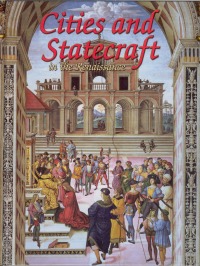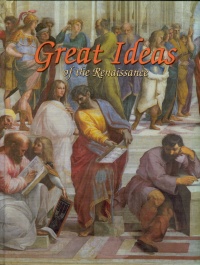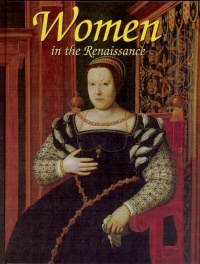| ________________
CM . . .
. Volume XVI Number 23. . . .February 19, 2010 
 |
Cities and Statecraft in the Renaissance. (Renaissance World).
Lizann Flatt.
St. Catharines, ON: Crabtree, 2010.
32 pp., pbk. & hc., $9.95 (pbk.), $20.76 (RLB.).
ISBN 978-0-7787-4615-7 (pbk.), ISBN 978-0-7787-4595-2 (RLB.).
Subject Headings:
Cities and towns-Europe-History-Juvenile literature.
Cities and town life-Europe-History-Juvenile literature.
Europe-Commerce-History-Juvenile literature.
Europe-Civilization-Juvenile literature.
Grades 5-9 / Ages 10-14.
Review by Suzanne Pierson.
***1/2 /4
|
| |
|
 |
Great Ideas of the Renaissance. (Renaissance World).
Trudee Romanek.
St. Catharines, ON: Crabtree, 2010.
32 pp., pbk. & hc., $9.95 (pbk.), $20.76 (RLB.).
ISBN 978-0-7787-4616-4 (pbk.), ISBN 978-0-7787-4596-9 (RLB.).
Subject Headings:
Renaissance-Juvenile literature.
Europe-Civilization-Juvenile literature.
Grades 5-9 / Ages 10-14.
Review by Suzanne Pierson.
***1/2 /4
|
| |
|
 |
Religion in the Renaissance. (Renaissance World).
Lizann Flatt.
St. Catharines, ON: Crabtree, 2010.
32 pp., pbk. & hc., $9.95 (pbk.), $20.76 (RLB.).
ISBN 978-0-7787-4617-1 (pbk.), ISBN 978-0-7787-4597-6 (RLB.).
Subject Headings:
Renaissance-Juvenile literature.
Church history-Middle Ages, 600-1500-Juvenile literature.
Church history-16th century-Juvenile literature.
Europe-Church history-Juvenile literature.
Catholic Church-Influence-Juvenile literature.
Grades 5-9 / Ages 10-14.
Review by Suzanne Pierson.
***1/2 /4
|
| |
|
 |
Women in the Renaissance. (Renaissance World).
Theresa Huntley.
St. Catharines, ON: Crabtree, 2010.
32 pp., pbk. & hc., $9.95 (pbk.), $20.76 (RLB.).
ISBN 978-0-7787-4618-8 (pbk.), ISBN 978-0-7787-4598-3 (RLB.).
Subject Headings:
Renaissance-Juvenile literature.
Women-History-Renaissance, 1450-1600-Juvenile literature.
Grades 5-9 / Ages 10-14.
Review by Suzanne Pierson.
***1/2 /4
|
| |
|

excerpt:
Merchant Banking
Bankers lent money for a fee to merchants –– even nobles, princes, and kings –– and made more money when the businesses they had helped establish were successful. Merchants did not want to carry around large numbers of coins so they gave their money to a banker to keep it safe. Bankers charged a small fee to do this. Often, if a noble could not pay back a loan, some of their land had to be given to the banker as payment for the loan. In this way bankers and merchants grew rich and, with this money, gained power. They demanded more say in city government to make sure that no laws or taxes were put into place that were unfair to their interests. (From Cities and Statecraft).
This series, "Renaissance World," provides a very good simplified overview of the European world between the early 1300s and the mid 1600s, as society moved from medieval times to modern times. Each book focuses on the changes that were occurring during this time from a different perspective. Each book also includes a table of contents, a simple glossary and index, and a list of further readings and web sites. The result is a very readable introductory resource, useful to those who are just beginning to acquire a background of information about this period of incredible change.
One weakness of this series is occasional typos and editing errors.
Speacial [sic] tags on clothing, were also used to identify non-Christians and women of poor character. (From Women in the Renaissance.)
Although unfortunate, these are all minor and should not distract from the significance of the information being presented.
One strength of the series is the illustrations. These include images of coloured woodcuts, sculptures, paintings, altarpieces, manuscript illustrations, and photographs. Each illustration is accompanied by a note of explanation.
Michelangelo's Pieta shows Christ after his death in his mother Mary's arms. The marble sculpture is noted for the details in the graceful folds of cloth, the natural position of Jesus''s limbs, and the quiet restraint and dignity of the figures. (From Religion in the Renaissance.)
The text is organized in two columns per page, with one topic per double page spread. Each topic is further divided into several subheadings. Interesting additional information is highlighted in a separate textbox.
Leonard
Leonardo da Vinci was the ultimate Renaissance Man. He was a brilliant Italian painter, sculptor, scientist, engineer, and inventor who knew a great deal about mathematics, botany, philosophy, geology, and architecture. Da Vinci was among the first to dissect human bodies, making drawings that greatly helped scientists understand anatomy. He also designed bridges and drew sketches of devices that have a lot in common with the modern helicopter, parachute, tank, and more. (From Great Ideas of the Renaissance.)
Cities and Statecraft in the Renaissance begins its look at the time period by identifying some of the effects of the bubonic plague. With both rich and poor dying, the old system of servitude fell apart. Trade, commerce, guilds, and a new merchant class developed to replace feudalism. Scholars and artists looked to ancient Greece and Rome in art, literature, science, architecture, and politics. Towns, cities and city-states competed with each other for power, artistic talent, and creativity. New forms of government were developed.
Great Ideas of the Renaissance includes topics such as religion, education, medicine and anatomy, astronomy and mathematics, art, literature and drama, music, architecture, commerce, warfare, and everyday life. As an introduction to the thinking of the time, this book presents a brief summary of many of the important developments in many different disciplines. Limited by the double page spread, no topic is dealt with in any depth so there is little context to any of the ideas. For example, the two paragraphs devoted to Galileo do not mention that some of his ideas were so controversial that he was tried by the Inquisition, forced to recant his view that the sun was at the centre of the universe, and spent the rest of his life under house arrest. Unfortunately, it would appear from this book that Renaissance women did not have any 'great ideas.'
Religion in the Renaissance examines the structure and role of religion in a society shattered by the bubonic plague. The importance of the Roman Catholic Church in Western Europe began to slip as people began to question why God had allowed the plague. Humanism developed as an alternative to the Catholic Church's teachings of the way to be a good Christian. The Inquisition was set up by the Catholic Church to fight the spread of Protestantism and other challenges to the Church's authority. Wars were fought between countries whose rulers supported different religions. Different religious groups fled Europe for North America to escape religious persecution. Missionaries also left and went to many different parts of the world to spread their beliefs.
Women in the Renaissance examines the many different roles of women in all levels of society during this time period. Considered inferior to men, women were supposed to serve their husbands or the church. Education was believed to be wasted on girls, although women of the higher classes and royalty were often taught to read and write. Against great odds, some Renaissance women did manage to become powerful, influential, and even wealthy. This book adds an important balance to the information in the other three books in the series.
Whether purchased separately or as a series, these books, with their large, clear black on beige text and beautiful illustrations, will be a very good addition to libraries looking for an entry level overview of the Renaissance world.
Highly Recommended.
Suzanne Pierson is a retired teacher-librarian, currently instructing Librarianship courses at Queen's University in Kingston, ON.

To comment
on this title or this review, send mail to cm@umanitoba.ca.
Copyright © the Manitoba Library Association. Reproduction for personal
use is permitted only if this copyright notice is maintained. Any
other reproduction is prohibited without permission.
NEXT REVIEW |
TABLE OF CONTENTS FOR THIS ISSUE
- February 19, 2010.
AUTHORS |
TITLES |
MEDIA REVIEWS |
PROFILES |
BACK ISSUES |
SEARCH |
CMARCHIVE |
HOME |



